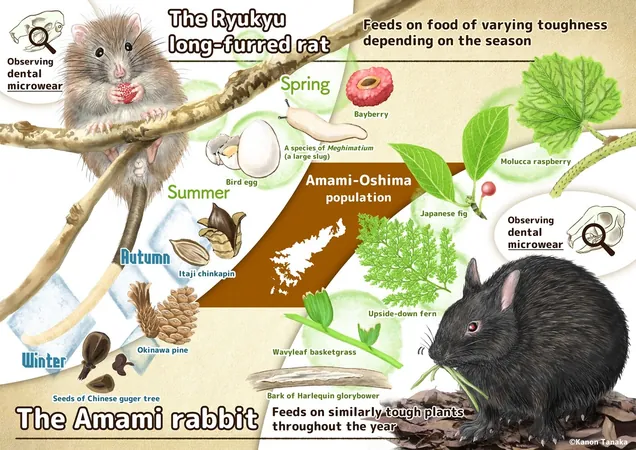
Unlocking the Secrets of Japan's Elusive Mammals: What Their Teeth Reveal About Survival and Conservation
2025-04-07
Author: Wei Ling
Introduction
In the lush, undisturbed forests of Japan's Ryukyu Islands, including the renowned Okinawa, reside two of the nation's rarest mammals: the Amami rabbit and the Ryukyu long-furred rat. Despite being notoriously elusive, researchers are now delving into the dietary habits of these unique creatures to bolster conservation efforts.
Research Methodology
A team led by scientists from the University of Tokyo meticulously examined the teeth of deceased specimens to uncover critical information about their diets. Their findings, recently published in the journal Mammal Study, unveil fascinating insights: while Amami rabbits maintain a consistent diet throughout the year, the Ryukyu long-furred rats display notable seasonal variations in their food preferences.
Wildlife of Okinawa
When one thinks of Okinawa, it often conjures images of sun-kissed beaches and vibrant waters. However, these islands are also home to remarkable wildlife long adapted to the subtropical environment. The Amami rabbit, often referred to as a 'living fossil,' and the similarly rare Ryukyu long-furred rat are at a heightened risk of extinction, particularly as climate change and human activities increasingly threaten their habitats.
Impact of Environmental Changes
Associate Professor Mugino Kubo, a leading researcher in this study, emphasized the ramifications of environmental shifts on these native species: 'Climate change and human encroachment can drastically alter their habitats, which directly impacts their food sources and feeding behaviors.' The study's goal is to clarify the feeding habits of these mammals, thereby enhancing the effectiveness of conservation strategies.
Dental Microwear Analysis
Using advanced three-dimensional texture analysis, Kubo and her team examined the microscopic wear patterns, or microwear, on the teeth of both the Amami rabbit and the Ryukyu long-furred rat. By cross-referencing these natural samples with teeth from laboratory-raised rodents that had established dietary histories, the researchers gained a clearer picture of what the wild populations consume.
Findings
The results are illuminating. Amami rabbits consistently consume tough vegetation, like ferns, year-round, as evidenced by the stable wear patterns on their teeth. Conversely, the Ryukyu long-furred rats exhibit a more dynamic diet: they feast on soft fruits, slugs, and eggs during the summer months, while opting for harder foods such as seeds and acorns in the winter.
Significance of the Study
'This research underscores the significance of dental microwear texture analysis in revealing the feeding strategies of rare species that are difficult to observe directly in their natural habitats,' Kubo noted. 'These findings also highlight the need for more nuanced ecosystem management that takes seasonal dietary shifts into account.'
Future Research Plans
Looking ahead, Kubo's team is eager to expand their research further. They plan to conduct comparative studies of these species across various islands in the Ryukyu chain and employ DNA analysis to deepen their understanding of their dietary habits. This crucial research may very well hold the key to ensuring the survival of these remarkable mammals in the face of ongoing environmental challenges.
Conclusion
Stay tuned as we continue to uncover the secrets of Japan's rare wildlife!






 Brasil (PT)
Brasil (PT)
 Canada (EN)
Canada (EN)
 Chile (ES)
Chile (ES)
 Česko (CS)
Česko (CS)
 대한민국 (KO)
대한민국 (KO)
 España (ES)
España (ES)
 France (FR)
France (FR)
 Hong Kong (EN)
Hong Kong (EN)
 Italia (IT)
Italia (IT)
 日本 (JA)
日本 (JA)
 Magyarország (HU)
Magyarország (HU)
 Norge (NO)
Norge (NO)
 Polska (PL)
Polska (PL)
 Schweiz (DE)
Schweiz (DE)
 Singapore (EN)
Singapore (EN)
 Sverige (SV)
Sverige (SV)
 Suomi (FI)
Suomi (FI)
 Türkiye (TR)
Türkiye (TR)
 الإمارات العربية المتحدة (AR)
الإمارات العربية المتحدة (AR)